

The following text is taken from the Autograph web site of Richard Norrish:
"This part of the web site is dedicated to the famous Tannoy Autograph and GRF Horn Loaded loudspeaker enclosures. I have owned my 15" Monitor Gold drivers from new. Originally they were fitted to a small sealed enclosure and some years later I made the corner mounted York enclosures. I was not particularly impressed with either of these two enclosures and eventually got plans from Tannoy for the Corner mounted GRF and Autograph enclosures. About 5 years ago I decided to build the GRF enclosure, as it looked simpler than the Autograph. After much head scratching I made a quarter size model and once satisfied that I fully understood how the enclosure went together, I made the real thing. I used 19mm Marine plywood (no air voids) for top and bottom panels and all other panels were made from 12.5mm ply. The sound improvement was amazing --- I really didn't think that a horn-loaded system would improve the sound THAT much. I used the GRF's for a number of years but it was always in the back of my mind that the ultimate enclosure was the front and rear horn loaded Autograph. I scratched around on the Internet, looked at the Tannoy plans for many hours and eventually had a go at building a quarter scale model. In March 2004 I began building one of the enclosures. I firstly cut out the side, top and bottom panels and temporarily put it together to see how large the enclosure was---these are BIG enclosures and I thought my wife would divorce me knowing that I wanted to put them in the living room. It took many days and long nights to finish one of these enclosures but the results were well worth the effort and expense. After many hours of hard, but enjoyable work I have finally finished both enclosures. They have been glued and screwed and the only thing left to do is to apply a clear finish to the Marine Plywood. I have mounted both enclosures in corner positions in the room. It is very important to make the enclosures as rigid as possible as unwanted resonances can cause significant coloration of the sound. Having listened to both enclosures I can say the sound is much different to the GRF. The Autograph is noticeably more efficient than the GRF, especially in the mid frequency range. One of the weaknesses of the GRF is that it sounds a bit thin in the mid frequency range. The Autograph on the other hand has a very nice fast mid frequency response. Voices sound full and natural and instruments like Bongos have a fast transient response. These enclosures need to be corner mounted and in a large room in order to get good low frequency bass radiation. The bass harmonics are very well defined."
Pictured below are the construction stages of the Autographs built by me: Richard Norrish in Adelaide, South Australia. Once again. an even more difficult project than the GRF horns, the results are that much better again. The sound is fuller, has better midrange (albeit slightly less apparent low bass), and overall a tighter but warmer sound with better efficiency. Richard is currently running the horns on two class 'D' amplifiers sourced from http://www.hypex.nl/.
Plans for the Autograph were based on those at: http://myurata.hp.infoseek.co.jp/en/grf/grf_01.html
Just to recapitulate: the main difference between the sound of horns and conventional direct radiator designs is not the amount of bass, or even the frequency response characteristics as a whole, but more the ability to reproduce transients as they occur in real life. The horn enables the speaker to couple to the air with very high efficiency and very high damping. It is the coeffeicient of coupling to the air that is so different from direct radiator speakers, and the reason why inefficient speakers can never deliver realistic transient response. The typical bass reflex design produces large amounts of "fake bass" because the speaker in conjuction with the vent rings and smoothes out transients into lumps or thumps of largely irrelevant low frequency information. This pads out the sound and gives the impression of extended response. Obviously this is an excellent and cheap way of enhancing the performance of small speakers, but is totally off beam for large units. This observation, by the way, is coming from a person who has been a fan of bass reflex designs all his life! A good test for a speaker is to input a square pulse - theoretically the output should be nothing because the pulse consists of DC and infinitely high rise times. With an average speaker the output will be a loud thump because the speaker acts as a low pass filter, and rings excessively. With a good horn design, the output is minimal, due to the very high damping and efficiency. The upshot of all this is the horn design has the ability to seperate bass and midrange information and produce an astounding 3D sound stage. The less "produced" and gimmicky the recording is, the better it sounds. Kick drums "kick" and stop, they don't thump. 10 watts per channel fills the room with concert like volume, and even at very high volumes the cones barely move. Turn up the wick and they just keep getting louder without stress or compression. Having heard these Tannoys in more conventional enclosures I can say that the transformation is total. It also shows that conventional measurements performed on loudspeakers such as swept sine wave response curves are fairly meaningless as a basis for comparison - there are simply too many variables in complex musical waveforms.
Why are there so many people who don't like horn speakers? My guess is, for one thing they are large; incredibly expensive to buy (in Australia the Tannoy
Westminster Royal HE would tally at about $49,000), or so difficult to make, most people may rationalize that they aren't interested.
Once again Richard used Corel Draw to calculate the missing bits of data from the plans, and print life size templates for routing the top and bottom pieces. He constructed a quarter size model from high density cardboard to proof build the design before going ahead with the real thing.
Please note that Tannoy has since declined to supply these designs to further inquirers; although there is now good info on the net for all this.
| Here's agood link for Tannoy history: Kiewa Valley Stereo site. |  |
For a comprehensive collection of detailed shots go to Rick's Autograpah site:
| The finished enclosure: |
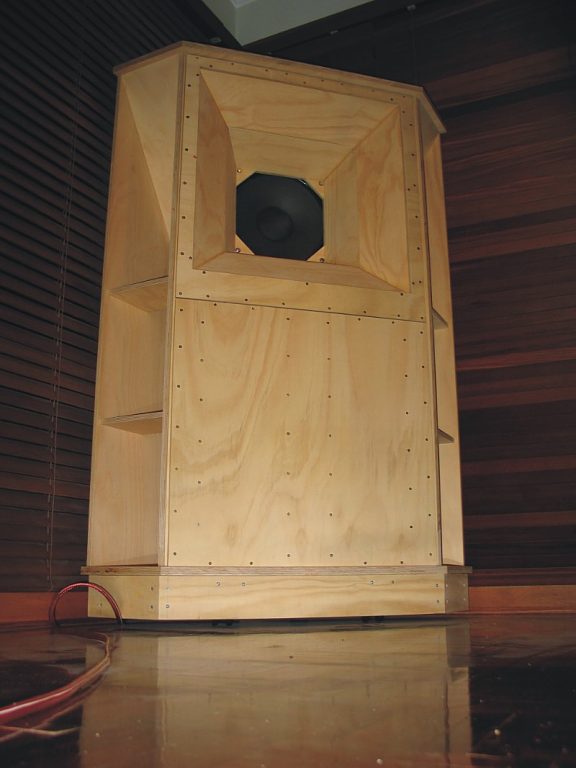 |
| Horn detail: |
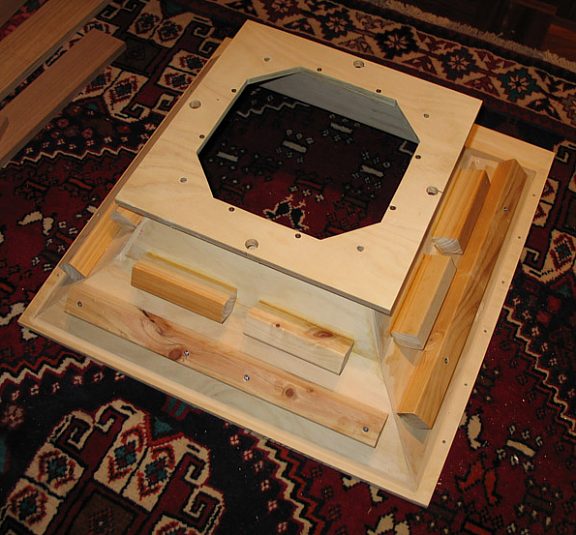 |
|
During construction with model: |
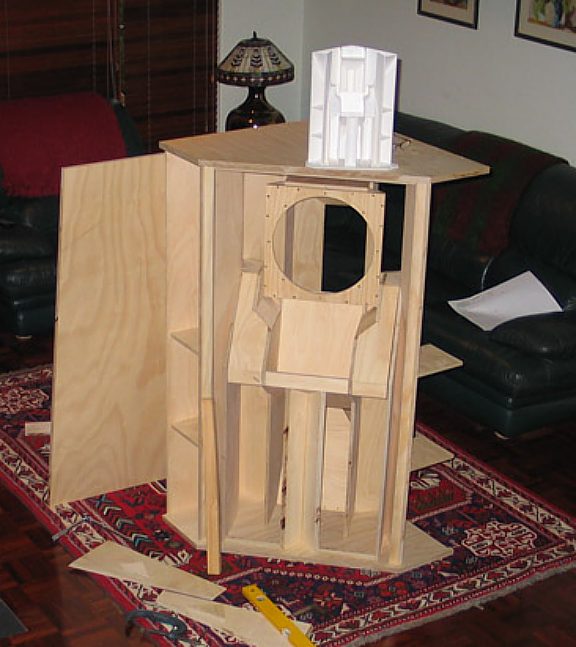 |
|
During construction: |
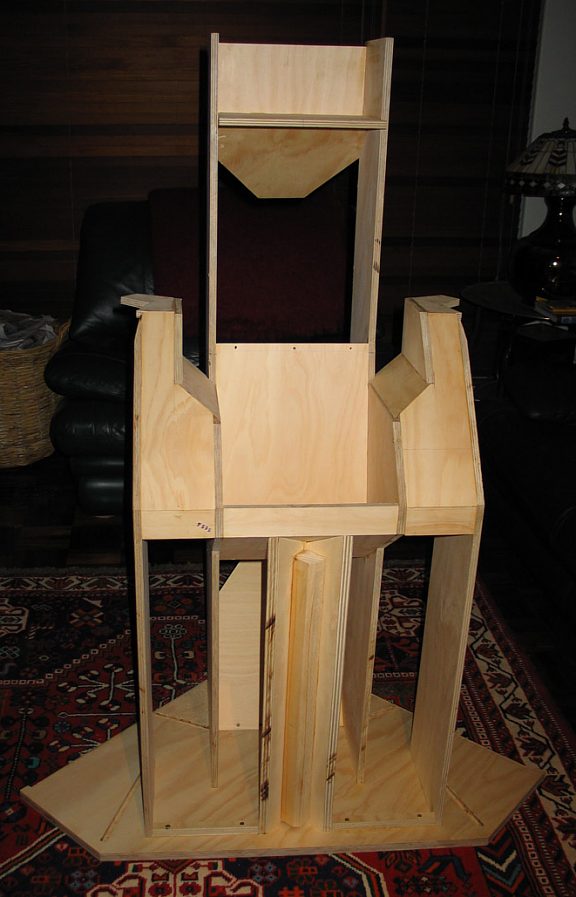 |
| The builder Richard Norrish with Tannoy Monitor Gold next to the older GRF horns. |
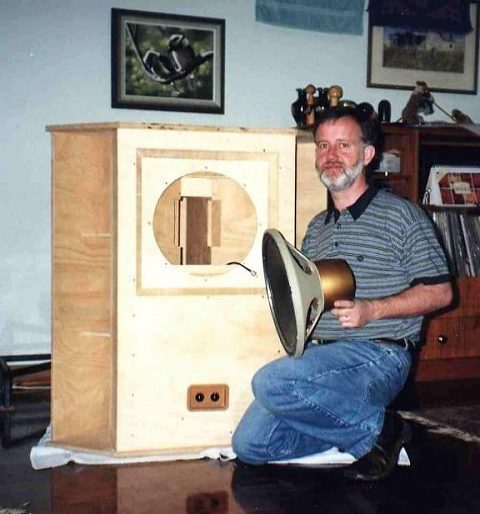 |
| To page 2. |
| To Crossover mods page |
| To original Tannoy brochure. |
| To Kel's HOME PAGE |